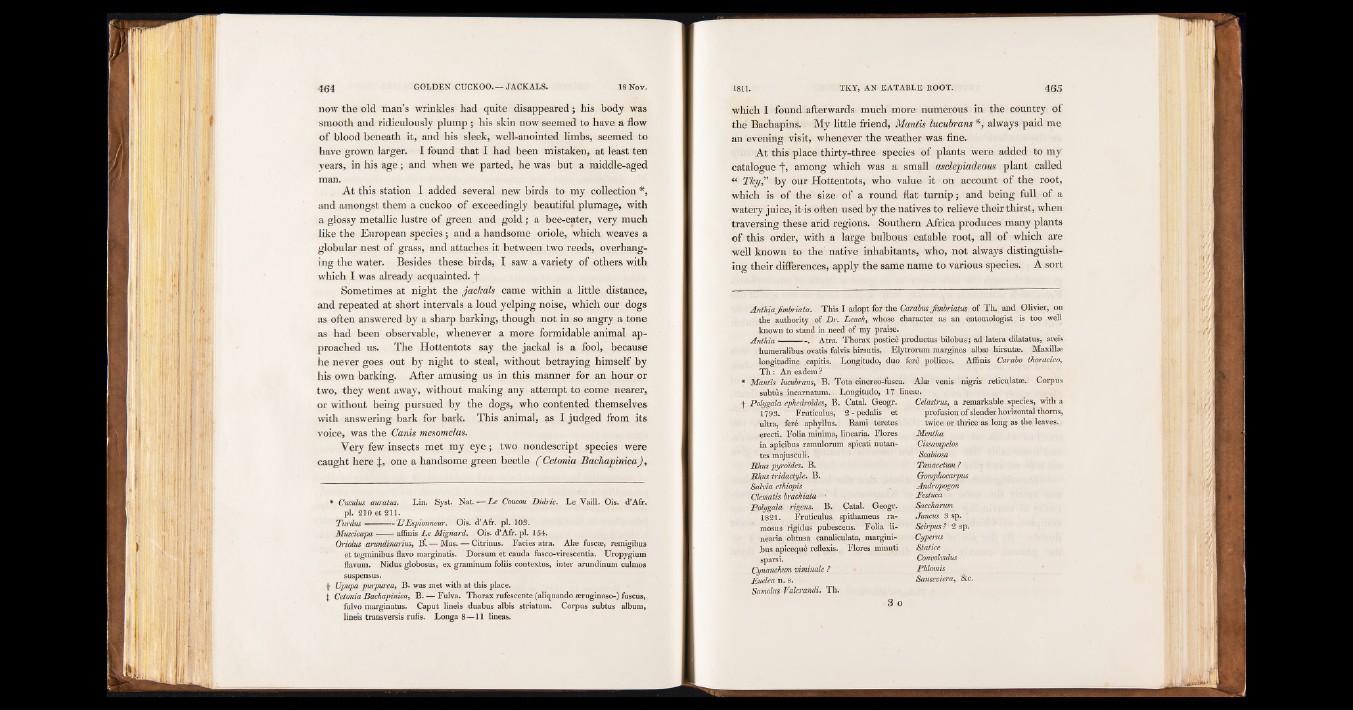
now the old tnan’s wrinkles had quite disappeared; his body was
smooth and ridiculously plump j his skin now seemed to have a flow
of blood beneath it, and his sleek, well-anointed limbs, seemed to
have grown larger. I found that I had been mistaken, at least ten
years, in his age; and when we parted, he was but a middle-aged
man.
At this station I added several new birds to my collection *,
and amongst them a cuckoo of exceedingly beautiful plumage, with
a glossy metallic lustre of green and gold; a bee-eater, very much
like the European species; and a handsome oriole, which weaves a
globular nest of grass, and attaches it between two reeds, overhanging
the water. Besides these birds, I saw a variety of others with
which I was already acquainted, f
Sometimes at night the jackals came within a little distance,
and repeated at short intervals a loud yelping noise, which our dogs
as often answered by a sharp barking, though not in so angry a tone
as had been observable, whenever a more formidable animal approached
us. The Hottentots say the jackal is a fool, because
he never goes out by night to steal, without betraying himself by
his own barking. After amusing us in this manner for an hour or
two, they went away, without making any attempt to come nearer,
or without being pursued by the dogs, who contented themselves,
with answering bark for bark. This animal, as I judged from its
voice, was the Canis mesomelas.
Very few insects met my eye; two nondescript species were
caught here %9 one a handsome green beetle ( Cetonia Bachapinica)y
* Cuculus auratus. Lin. Syst. N a t — Le Coucou Didric. Le Vaili. Ois. d’Afr.
pi. 210 et 211.
Turdus-----------L’Espionneur. Ois. d’Afr. pi. 103.
Muscicapa affinis Le Mignard. Ois. d’Afr. pi. 154.
Oriolus arundinarius, B. — Mas. — Citrinus. Facies atra. Alae fuscae, remigibus
et tegminibus flavo marginatis. Dorsum et cauda fusco-virescentia. Uropygium
flavum. Nidus globosus, ex graminum foliis contextus, inter arundinum culmos
suspensus.
f Upupa purpurea, B. was met with at this place.
X Cetonia Bachapinica, B. — Fulva. Thorax rufescente (aliquando aeruginoso-) fuscus,
fulvo marginatus. Caput lineis duabus albis striatum. Corpus subtus album,
lineis transversis rufis. Longa 8—11 lineas.
which I found afterwards much more numerous in the country of
the Bachapins. My little friend, Mantis lucubrans *, always paid me
an evening visit, whenever the weather was fine.
At this place thirty-three species of plants were added to my
catalogue j*, among which was a small asclepiadeous plant called
“ Thy” by our Hottentots, who value it on account of the root,
which is of the size of a round flat turnip; and being full of a
watery juice, it-is often used by the natives to relieve their thirst, when
traversing these arid regions. Southern Africa produces many plants
of this order, with a large bulbous eatable root, all of which are
well known to the native inhabitants, who, not always distinguishing
their differences, apply the same name to various species. A sort
Anthiajimbriata. This I adopt for the Carabus Jimbriatus of Th. and Olivier, on
the authority of Dr. Leach, whose character as an entomologist is too well
known to stand in need of 'my praise.
An th ia---------- . Atra. Thorax posticé productus bilobus; ad latera düatatus, aréis
humeralibus ovatis fulvis hirsutis, Elytrorum margines albae hirsutas. Maxillae
longitudine capitis, Longitudo, duo feré pollices. Affinis Carabo thoracico,
T h : An eadem?
* Mantis lucubrans> B. Tota cinereo-fusca. Alae venis- nigris reticulatas. Corpus
subtus incarnatum.. Longitudo, 17 lineas.
-J- Polygala ephedro'ides, B. Catal. Geogr.
1793. Fruticulus, 2-pedalis et
ultra, ferè aphyllus. Rami teretes
erecti. Folia minima, linearia. Flores
in apicibus ramulorum spicati nutan-
tes majusculi.
JRJius pyroìdes. B.
BJius tridactyle. B,
Salvia ethiopis
Clematis brachiata *
Polygala rigens. B. Catal. Geogr.
1821. Fruticulus spithameus ramosus
rigidus pubescens. Folia linearia
obtusa canaliculata, margini-
bus apicequè reflexis. Flores minuti
sparsi.
Cynanchum V im in a le ?
Euclea n. s.
Samolus Valerandi. Th.
Celastrus, a remarkable species, with a
profusion of slender horizontal thorns,
twice or thrice as long as the leaves,,
Mentha
Cissampelos
Scabiosa
Tanacetum ? ;
Gomphocarpics .
Andropogon
Festuca
Saccharum
Juncus 3 sp.
Scirpus?' 2 sp.
Cyperus
Statice
Convolvulus
Phlomis
Sanseviera, &c.